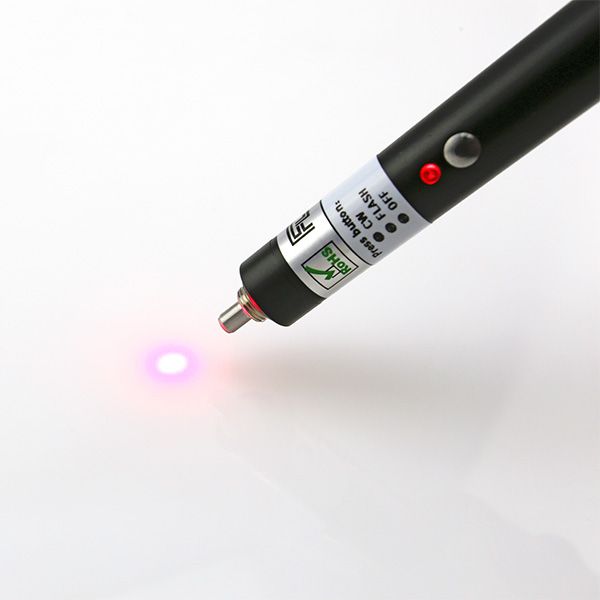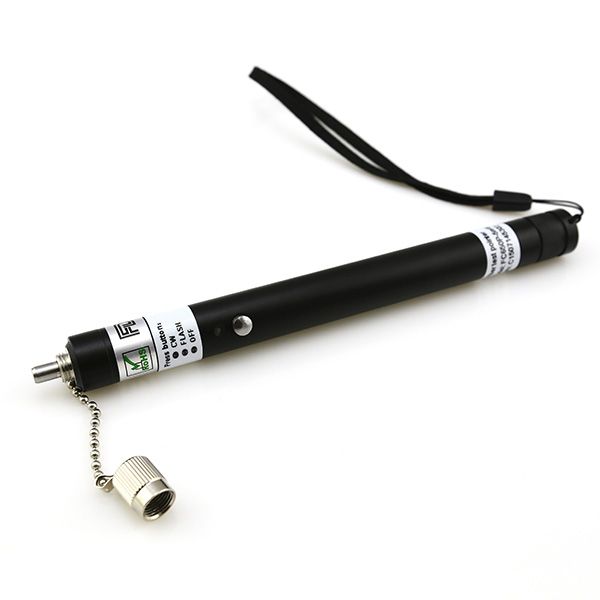
The fiber optic detector can evaluate the quality of fiber optic connection by detecting the loss of optical signal. The following are its specific methods, performance advantages and structural features:
Methods for testing the quality of fiber optic connection
Insertion loss detection
Connect the red laser light source transmitting end of the fiber optic detector to one end of the fiber optic connection point to be tested, and connect the optical power meter or the receiving end of the fiber optic test pen to the other end of the connection point. The 650nm red laser pen emits a highly visible red laser light as an optical signal of a specific wavelength and power.
After the optical signal is transmitted through the fiber optic connection point, the optical power value is measured by the receiving end or the optical power meter. By comparing the transmitted optical power and the received optical power, the insertion loss of the fiber optic connection point can be calculated. Generally speaking, the lower the insertion loss, the better the quality of the fiber optic connection. If the insertion loss exceeds the specified standard value, it indicates that there is a problem with the connection point, such as loose connection, uneven fiber end face, dust or impurities, etc.
Return loss detection
The fiber optic detector emits an optical signal into the optical fiber, and then detects the intensity of the optical signal reflected back from the fiber optic connection point. Return loss reflects the reflection of the optical signal at the fiber optic connection point, which is related to factors such as the end face quality of the connection point and the concentricity of the optical fiber.
A higher return loss value indicates that the connection point has less reflection of the optical signal and the connection quality is better; conversely, if the return loss value is low, it means that there is a large reflection at the connection point, which may cause reflection interference of the optical signal and affect the performance of the optical fiber communication system.

Performance advantages
High-precision measurement: fiber optic detector can accurately measure parameters such as insertion loss and return loss of the optical fiber connection point, and the measurement accuracy can usually reach ±0.1dB or even higher, providing accurate data support for evaluating the quality of optical fiber connection.
Fast detection: The detection of optical fiber connection quality can be completed in a short time, and the detection results can generally be obtained in a few seconds to tens of seconds, which greatly improves the detection efficiency and is suitable for on-site rapid detection and troubleshooting.
High resolution: fiber optic detector has a high resolution for the changes in optical signals, and can detect small changes in optical power and reflection signals. Even small connection quality problems can be accurately detected.
Stable and reliable: It uses high-quality and high density red laser light sources and photoelectric detection devices, has good stability and reliability, can maintain accurate measurement performance under different environmental conditions (such as temperature and humidity changes), and reduce misjudgment and missed judgment.
Structural features
Compact and light: The overall structure of fiber optic detector is compact, small in size, light in weight, easy to carry and operate, and easy to use in different work sites, such as testing in a small machine room space or outdoor fiber optic laying site.
Modular design: It usually adopts a modular structure, including red light source module, optical transmission and receiving module, signal processing module, display module, etc. Each module is independent of each other and works together, which is convenient for maintenance and upgrading. If a module fails, it can be easily replaced or repaired.
Multiple interfaces: 650nm wavelength fiber optic detector is equipped with multiple types of fiber optic interfaces, such as FC, SC, LC, ST, etc., which can adapt to different types of fiber optic connectors, convenient for connection with various fiber optic lines, and improve the versatility and compatibility of the equipment.
Intuitive display: The display module is usually a liquid crystal display (LCD), which has a clear and intuitive display effect. It can display the test results in various ways such as numbers and graphics, such as insertion loss value, return loss value, optical power value, etc., which is convenient for operators to quickly read and understand the test data.
Easy operation: The operation interface of the equipment is simple and clear, and usually has several function buttons for setting test parameters, starting detection, viewing results, etc. Even first-time users can quickly get started and easily operate and master.
